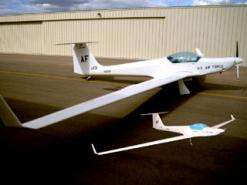Research Could Cut Aircraft Development Costs, Improve Safety

A distressing fact for aeronautical engineers: Scale model airplanes don't fly anything like their full-sized counterparts. And that makes aircraft design a lot more difficult.
“Right now, for developing a new airplane, there's only so much you can do with wind tunnel testing and computations,” said Hermann Fasel, a professor in the aerospace and mechanical engineering department at The University of Arizona.
“Then you have to make a big jump and build a full-sized airplane, a prototype. Then you fly and test this airplane to see if it performs as predicted by calculations and wind tunnel tests. Oftentimes, engineers have to make major changes, in view of flight test results, in order to not compromise the efficiency and safety of the original design.”
Supercomputers to the Rescue
Fasel is using some of the world's largest supercomputers to crack this problem by constructing simulations that create scale models with the same flight characteristics as their full-sized counterparts.
Aircraft companies are interested in Fasel’s "dynamically scaled flight" research because it could save them millions of dollars by shortening the time needed to develop new aircraft. Simultaneously, it would create safer airplanes.
What's needed is a way to decode the nonlinear relationships that link the airflow around models to that around full-sized aircraft. But this hasn't been possible in the past because engineers didn’t understand the physics of airflow, particularly the complex interaction between transition and separation – that is, the change between the time when air is flowing smoothly across a surface and when it separates from the surface and becomes turbulent.
Engineers now are gaining a better understanding of complex flow physics problems because of the computing power available in newer supercomputers.
Fasel is one of a handful of engineers with the extensive background in flow transition physics and computational sciences needed to take full advantage of the increasing capabilities of supercomputers. He has received Department of Defense and Department of Energy grants for millions of supercomputing hours to carry out this work.
Motorglider Serves as Testbed
Fasel and his students have built 1/5-scale models of a motorglider – a sailplane with an engine that can be turned on and off during flight. The U.S. Air Force has four of these full-sized motorgliders at the Edwards Air Force Base Test Pilot School that also are being used in the research.
“The motorglider is ideal for this kind of flight research because you can investigate the aerodynamics with and without the noise from the engine and propeller,” Fasel said. “Noise and vibrations can affect the transition from laminar to turbulent flow, and as a consequence of that, affect separation.”
The Air Force planes and the models will be flown through the same flight tests so that data from model and full-sized plane can be compared directly.
“My students carry out enormous computational fluid dynamics simulations,” Fasel said. “These are some of the largest simulations that have ever been done on any problem.” Some of the problems require months of calculations by the most powerful supercomputers available.
Going Where Real Planes Can’t
Once accurate scale models can be built and simulated in computers, the best designs can be flown in ways that might cause structural damage to a real plane and would never be tried on full-sized aircraft because the plane and pilot might not survive.
“One motivation of this research is to reduce the cost of developing airplanes. And the other one – and this can be done even if the airplane already exists – is reducing risk and improving safety by testing in certain flight regimes where you wouldn't put a full-sized, $500 million prototype airplane,” Fasel said.
Currently, Fasel’s group is developing a larger scale model, a 1/3 scale of a Cirrus SR22, to expand the research effort.
Fasel's dynamically scaled flight research is funded by a NASA Small Business Technology Transfer grant through Advanced Ceramics Research Inc., of Tucson, and the Air Force Office of Scientific Research.
Source: University of Arizona





















